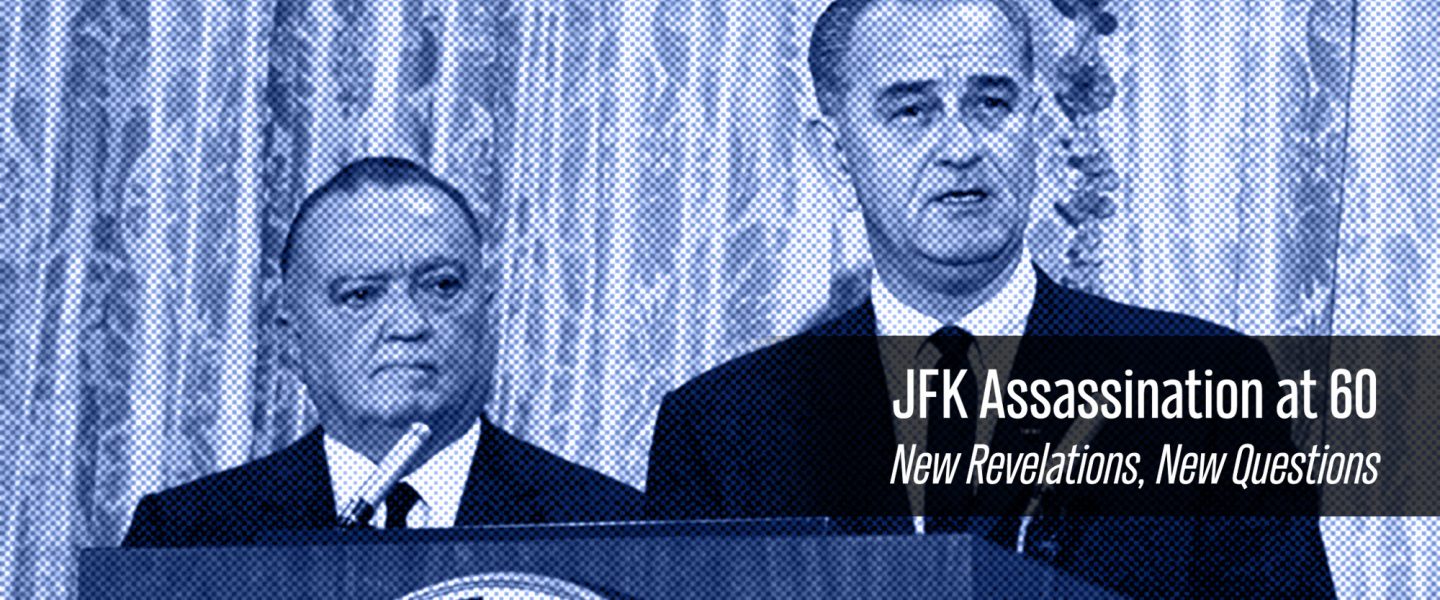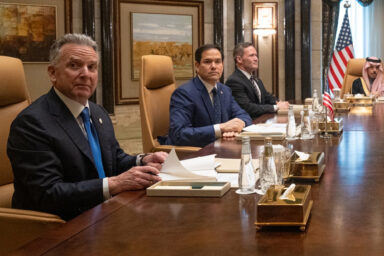It seems FBI Director Hoover corroborated in 1963 what Secret Service Agent Paul Landis is now saying about the Kennedy assassination bullet discovery.
|
Listen To This Story
|
On November 29, 1963, one week after the assassination in Dallas of John Kennedy, newly installed President Lyndon Johnson called FBI Director J. Edgar Hoover for an update on the FBI’s investigation so far.
As we described in our earlier report about this historic phone call, Johnson suggested — and Hoover affirmed — in guarded but unmistakable language, that at least one of the shots striking the president had been fired from in front of Kennedy’s limousine. (Go here for complete transcript and audio version.)
This private conversation contradicted the emerging official story, which held that Kennedy had been killed by a lone assassin, a young New Orleans native named Lee Oswald, who supposedly shot Kennedy (also wounding Texas Gov. John Connally) from a floor high up in the Texas School Book Depository building where he had recently landed a job.
Because Kennedy’s limo had already passed Oswald’s building when the shooting began, if Oswald alone had been firing, all the shots would have come from behind. But here were the two men discussing at least one shot from up ahead. Furthermore, the men referred to the shooters as “they,” clearly suggesting shots from more than one person.
In this installment, we continue to examine this call in detail, contrasting the Hoover-Johnson dialogue with the ultimate narrative Johnson’s hand-picked Warren Commission later presented to the American people.
The Boss Wants an Update
As we begin our consideration, please bear in mind that, only one week after the crime, the evidence was still in flux and much was unconfirmed. Hoover, whose FBI directorship had already spanned four presidencies, was a master of bureaucratic and political wiles who would have wanted to impress his new president with the FBI’s acumen. In fact, he was a notorious braggart, both in public and in private, and given to hyperbole. So he may have presented things to Johnson as factual when they were still ambiguous — a sort of “hot take.”
Nonetheless, Hoover understood the stakes. He was the head of the country’s leading law enforcement agency and had tremendous information-gathering resources. He was talking to the president of the United States, so he’d presumably prepared well for the call and was careful and precise in his statements, aware of what he was saying and the implications and consequences of each point.
With that in mind, let’s now go beyond the tantalizing issue of a possible shooter at the front of the motorcade to scrutinize a second, equally intriguing aspect of that November 29 call.
It involves what appears to be surprising corroboration of a recent claim by a former Secret Service agent, who was present during the Dallas motorcade, about his discovery of a bullet — and the location of that bullet.
What Was Found and Where
At one point in their conversation, Hoover explains to Johnson:
The third shot is a complete bullet… and that rolled out of the President’s head. It tore a large part of the President’s head off. And in trying to massage his heart at the hospital — on the way to the hospital — they apparently loosened that and it fell onto the stretcher. And we recovered that; and we have that.
On reflection, that seems a rather jarring statement — since it directly contradicts the Warren Commission’s eventual story. The panel’s report, issued roughly nine months later, would state that a bullet was recovered not as Hoover told Johnson on Kennedy’s stretcher, but on Connally’s.
That makes a huge difference, because the place where the bullet was found would crucially affect our understanding of the shots — and perhaps the number of shooters.
The Commission report was built on a scenario in which the bullet allegedly found on Connally’s stretcher had traveled first through Kennedy and then through the governor. This scenario followed the Commission’s stated objective of explaining how Oswald did it, rather than exploring who might have done it. In line with this objective, the Commission formulated a story about one very busy bullet. Had the panel not done so, given the intervals between the shots visible on a movie of the motorcade taken by a bystander, it would have been unconvincing to claim one shooter fired them all. (More on this below.)
But in briefing the new president on the investigation, Hoover doesn’t merely contradict what the Warren Commission would later promulgate as the definitive story of the assassination: As we shall see, he actually invalidates a core contention of the Commission.
That contention is the basis for the government’s whole case that one man, acting alone, was guilty.
Does Hoover 1963 Corroborate Landis 2023?
Today, Hoover’s long-ago, little-studied statement to Johnson takes on new significance because it appears to lend credence to a recent declaration by Paul Landis, one of the Secret Service agents in the car behind the limousine that day. Landis, in a new book, says that on November 22, just after the limousine arrived at the hospital, he found an intact bullet atop its back seat, not far from where Kennedy’s head had been
According to Landis, he was worried that the projectile might be lost amid the chaos, so he grabbed it as crucial evidence and shortly thereafter placed that bullet on Kennedy’s stretcher in the emergency room, hoping it might help the doctors understand Kennedy’s wounds.
Landis’s latest revelation is certainly important. But, as we previously reported, his claims have changed over the years. Landis admits not only that he failed to report finding the bullet at the time, but also that he provided accounts, in interviews since then, that differed in important ways from what he now affirms to be the truth. He cites as his reason for these discrepancies personal trauma and fear of the risks involved in coming forward. (This may well be true; unlike most of his colleagues, he left the Secret Service soon after the assassination.)
Whatever one may think of his account, Hoover’s long-overlooked comment to Johnson can be seen as potentially corroborating Landis’s assertion.
That means that, if indeed a bullet came out of Kennedy’s head and, through the actions of Landis, ended up on Kennedy’s stretcher — and never was on Connally’s stretcher — then the entire convoluted Warren Commission theory is wrong.
Why Connally’s Stretcher
The Warren Commission, it must be understood, was under intense pressure to deliver a persuasive and authoritative report convincing the public that the culprit had been apprehended and the matter settled. Before the Commission was convened, the FBI had leaked a hastily compiled report pinning the assassination on Oswald alone. But this leak wasn’t enough to persuade the news media to declare the “crime of the century” so quickly solved. More was needed, so Deputy Attorney General Nicholas Katzenbach drafted a memo on the importance of quashing speculation about the assassination, which then led to the creation of the Warren Commission.
The problem it faced in constructing its preferred story of a solo assassin was that several lines of evidence pointed to the existence of too many shots, suggesting a conspiracy.
***
One of the main stumbling blocks was the now iconic home-movie footage taken at the scene by a local businessman, Abraham Zapruder.
Although not publicly released at the time, enough people had seen this film and knew that it showed what appeared to be Kennedy and Connally each in turn reacting to separate shots fired at separate times. Furthermore, these two shots seemed to come too close together to have been fired by the gun attributed to Oswald.
In fact, Connally himself would say he thought “two or three people [were] involved … or someone was shooting with an automatic rifle.”
That is, not the slower, bolt-action weapon allegedly used by Oswald, and found hidden on the Book Depository’s sixth floor. But because the Zapruder film would be withheld from the general public until 1975, the Warren Commission could get away with advancing claims that the film actually disproved.
So the Commission created the so-called single-bullet theory, namely, that one bullet hit both Kennedy and Connally. In this scenario, the same bullet went into Kennedy’s back, out of his throat into Connally’s back, out of Connally’s chest into his wrist, then into his thigh, leaving behind a small fragment beneath the skin. Then, presumably, it fell out onto his stretcher. In this single-bullet theory, there were no longer two shots too close together to have come from Oswald’s slow bolt-action rifle. And Connally’s separate reaction, presumably to a different shot, was dismissed as nothing more than a “delayed reaction” to that same bullet.
The Big Picture Here
Given the discrepancies we report in this two-part article, it seems clear that what the authorities believed early on — what they were telling each other on the inside — was very different from what Johnson’s hand-picked Commission would soon report to the American people.
Students of history know that this happens with surprising frequency. Some palatable story is settled on because the real story is just too problematic or destabilizing.
And Johnson had, right from the first moments after Kennedy’s death, begun selling his colleagues on the need to agree on a plausible story. His reason? A raft of dubious material was already being disseminated by intelligence-connected sources, tying Oswald to a larger foreign conspiracy, with the implication that the shooting had been sponsored by Moscow.
Johnson, who himself doesn’t appear to have believed any of that, told his aides he was worried that if this rumor gained traction, it could trigger a military confrontation, even nuclear war. This became a kind of unspoken basis for agreement that it would not be good to peer too deeply into the whole matter, and to get it wrapped up fast.
Based on their actions, it is clear that Johnson and Hoover never had any interest in a deeply probing public investigation. Thus they set in motion the Warren Commission inquiry, which came to the lesser-of-two-evils conclusion that Oswald alone had done it — for unstated reasons that the young man took to his early grave.
But the evidence presented here suggests another possibility: that the assassination of John F. Kennedy was planned and carried out not by some Moscow-directed cabal, nor by Oswald alone — if at all — but by a home-grown conspiracy with multiple parts and participants.
In short, a highly compartmentalized domestic covert operation, planned and carried out by expert operatives who had done this sort of thing for years, all over the world, as part of their normal work.
About the JFK Assassination Series
This series was inspired by an ongoing project of WhoWhatWhy Founder and Editor-in-Chief Russ Baker to produce a definitive, meticulous, book-length investigation of Kennedy’s death. Robert Smith is a member of the research team assisting Mr. Baker with his forthcoming book.
Click here for the introduction to the series. To see all the articles in the series, click here.
If you have information to bring to our attention about any aspect of the JFK assassination — or are with the media and interested in covering or reproducing our work or inviting Mr. Baker to appear on a program — please click here.
If you would like to be on a mailing list to receive news of the book, click here.


